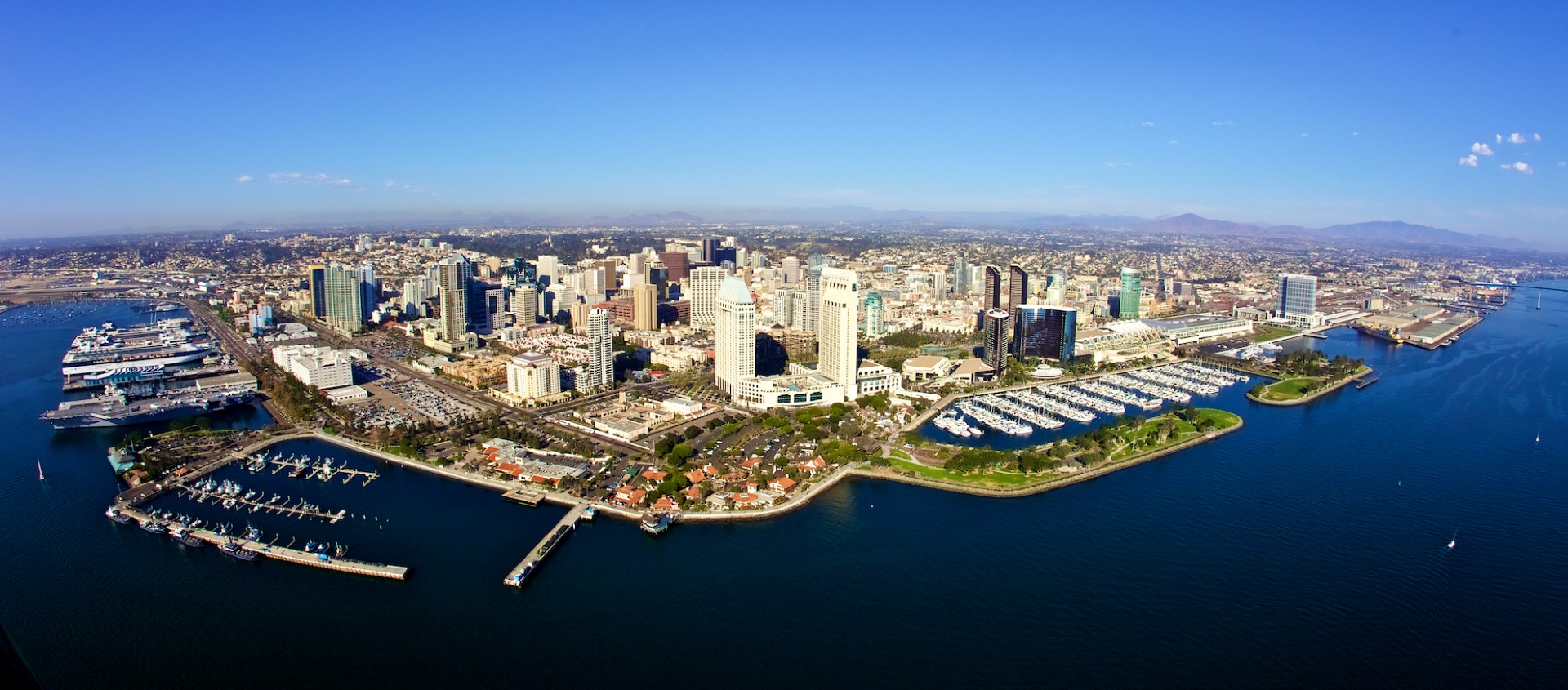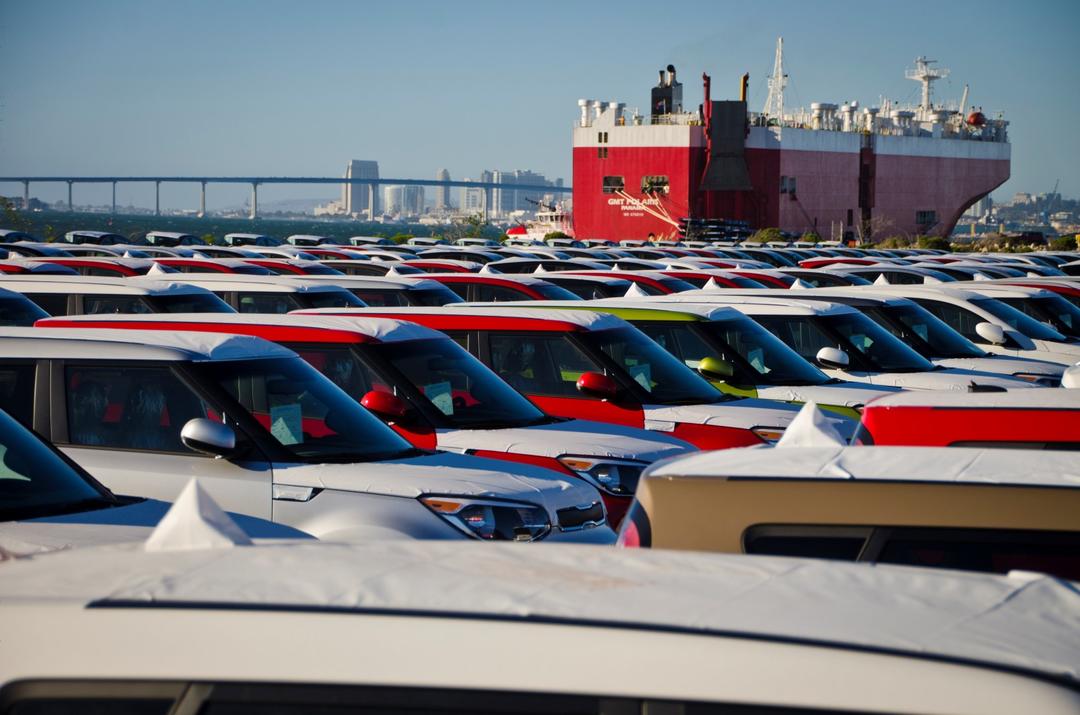Port of San Diego Marine Terminals
The Tenth Avenue and National City marine terminals are part of the Port’s working waterfront, which generates billions of dollars annually for San Diego's regional economy.
Cruise ships entering San Diego Bay dock at the B Street Cruise Terminal or the Port Pavilion on Broadway Pier along the Embarcadero. The Embarcadero is a two-mile stretch of waterfront in downtown San Diego that offers dining, shopping, lodging, museums and attractions.
Port of San Diego Maritime Terminal Access
Individuals requesting entry to a secure maritime terminal at the Port of San Diego must have a bona fide business purpose for entry to the terminal, a Transportation Worker Identification Credential (TWIC) issued by the U.S. Transportation and Security Administration (TSA), AND receive approval from the Port for terminal access. Secure Port of San Diego terminals include the Tenth Avenue Marine Terminal, the National City Marine Terminal (also referred to as the 24th St. Marine Terminal), and during certain vessel activity, the B Street Pier Cruise Ship Terminal and Broadway Pier.
If you are working or going to be working on a secure Port of San Diego maritime terminal (this includes Port employees, Port tenant/subtenant employees, contractors, subcontractors, and truck drivers), follow these steps:
- Click here to go to the TSA website to learn more about and to obtain a TWIC.
- Once TWIC is obtained, you may request terminal access. To get started, click here to request an application form from the Port of San Diego. Once you receive the form, fill it out and submit it. Your submission will be reviewed and processed in a timely manner, and you will be notified if approved or not.
Port of San Diego security staff reserves the right to determine access in accordance with the terminal’s Facility Security Plan (FSP). Individuals no longer needing access, or their employer/former employer, must notify Jake Englander, Port Facility Security Officer (FSO), in writing at jenglander@portofsandiego.org.
Maritime Escort Card Request
(For all TWIC holders)
Personnel without a TWIC must be escorted by a qualified escort while at the terminal. Personnel issued a valid TWIC are eligible to apply for an escort card. An escort card authorizes TWIC holders to escort non-TWIC holders to the terminal. To obtain a TWIC escort card, click the link below and follow the instructions.
Click here to take the online Maritime Security Awareness Training The cost of the 45-minute course is $50.00.
Once you have completed the course, please email jenglander@portofsandiego.org a copy of the following:
- Photo which includes your shoulders, no glasses, no hats, and a plain background
- Job Title
- Company Name
- TWIC Expiration Date
- Copy of Completed MSAT Certificate
Once we receive copies of the above items, we will arrange a pickup time. Escort cards are issued by appointment only and you must be present to receive your card. You will need to bring your TWIC card to access the terminal and receive your escort card. The office is located at the Tenth Avenue Marine Terminal - inside the main entrance.
Tenth Avenue Marine Terminal
The Port of San Diego is the only major West Coast port combining all the assets of a great natural, all-weather harbor and extensive on-dock distribution facilities with the resultant elimination of the expense of local drayage from on-dock to off-dock warehouses.
This provides the importer with a competitive advantage over all other West Coast ports. Principal inbound cargos are perishables and refrigerated commodities, fertilizer, cement, breakbulk commodities.
Features
- 96-acre complex
- Eight berths
- Depth of 42 feet
- Flexible, mobile harbor crane
- Flexible storage opportunities including cold storage, covered storage and open laydown space
- Approx. 300,000 sq. ft. (27,871 square meters) temperature controlled warehouse
- On-dock shore power and fueling
- 15 miles from U.S.-Mexico Border
- U.S. Customs and Federal USDA inspection services
- Minutes from interstates 5, 8, 15 and 805
Download Terminal Locations Map
Download TAMT Barrio Logan Truck Route Map
Contact us today for details on how our team can move your specialty cargo from ship to ground to market much faster. maritimeinfo@portofsandiego.org | 619.686.6300
National City Marine Terminal
The National City Marine Terminal, located on the National City waterfront at the south end of San Diego Bay, is the most advanced vehicle import/export facility on the West Coast.
Owned by the Port of San Diego, and operated by Pasha Automotive Services, the terminal serves as the primary port of entry for one out of every 10 new foreign cars shipped to the United States. Audi, Bentley, Chrysler, Fiat, Ford, GM, Hino, Honda, Hyundai, Isuzu, Itochu, Lamborghini, Mitsubishi Fuso, Porsche, Toyota and Volkswagen are all processed through the National City Marine Terminal (NCMT) by Pasha. The terminal also specializes in lumber and other large project cargo. A strong partnership with the International Longshore and Warehouse Union (ILWU) provides a skilled labor force to meet all shipping needs.
Features
- 135-acre complex
- Four working berths
- Depth of 35 feet
- 10 miles from U.S.-Mexico Border
- Direct access to on-dock class I rail
- Minutes from interstates 5, 8, 15 and 805
- Secure facilities for valuable cargo with 24-hour monitoring
- Flexible storage opportunities
Download Terminal Locations Map
Contact us today for details on how our team can move your specialty cargo from ship to ground to market much faster. maritimeinfo@portofsandiego.org | 619.686.6300
B Street Cruise Terminal/Broadway Pier
The Port has a 30,000-square-foot main cruise ship terminal building; two supplemental structures for passenger reception and baggage handling (totaling 15,000 sq. ft.); and 2 warehouse areas. Read more information about the terminal below.
PARTNER AMENITIES
•On-site offices for U.S. Customs and Border Protection and Cruise Lines
• Crew Amenities Center: Telephones, Internet access, wire service, video rental, sundries
• U.S. Customs and Border Protection and Cruise Lines
• Wireless Internet Access
TRANSPORTATION & PARKING
• Highway connections via Harbor Dr. (arterial), four-lane roadway
• Ample off-site parking and shuttle services available within one mile• Highway connections via Harbor Dr. (arterial), four-lane roadway
• Ample off-site parking and shuttle services available within one mile
MISCELLANEOUS
• Passenger loading bridge is equipped to handle embarkation and debarkation of passengers and baggage.
• Mechanical Handling Facility: Stevedore equipment available as needed.
• Contact terminal manager for load capacity• Passenger loading bridge is equipped to handle embarkation and debarkation of passengers and baggage.
• Mechanical Handling Facility: Stevedore equipment available as needed.
• Contact terminal manager for load capacity
OWNED & OPERATED BY The Port of San Diego
| TERMINAL | B Street Pier | Broadway Pier |
| LOCATION | 1140 N. Harbor Drive | 1000 N. Harbor Drive |
| PIER FOOTPRINT (meters) | 1000’ x 400’ 305m x 122m |
1000’ x 130’ 305m x 41m |
| BERTHING SPACE (meters) | 122 (west) 305 (north) 305 (south) |
41 (west) 305 (north) 305 (south) |
| BERTH NUMBER | 3 (west) 1, 2 (north) 4, 5 (south) |
3 (west) 1, 2 (north) 4, 5 (south) |
| DEPTHS ALONGSIDE ALL MLLW (meters) | 10.7 | 10.7 |
| WIDTH OF APRON | 26-10.6m (west) 11m (north) 8.8m (south) |
- (west) 4.9m (north) 4.9m (south) |
| HEIGHT DECK ABOVE MLLW | 4 meters | 4 meters |
| LIGHTING | Lighted on all sides | Lighted on all sides |
| INFRASTRUCTURE | • 120,000 sq. ft. of outdoor/total space with a rated capacity of 3,419 • 30,000 sq. ft. main terminal building • seating capacity of 850 to 1,550 • two supplemental structures for passenger reception and baggage handling (totaling 15,000 sq. ft.); • 2 warehouse areas (30,000 and 20,000 sq. ft.) |
• 52,000 sq. ft. cruise facility; 15,000 sq. ft. of baggage handling space • 55,000 square feet with a rated capacity of 2,600 • VIP lounge seating |
| TYPE OF CONSTRUCTION | • Concrete retaining walls • Paved solid fill in center with 18.3m side • Concrete pile • Concrete decked extensions along sides and face |
• Concrete pile • Concrete deck |
| UTILITIES |
|
|
| FIRE PROTECTION (in addition to city Fire Department) | • Sprinkler system in terminal • Hose, hand and chemical cart extinguisher • Watchmen |
• Sprinkler system in terminal |
| ACCOMMODATES | • Cruise vessel operations • U.S. Customs • Special Events |
• Cruise vessel operations • Visiting ships • U.S. Customs • Special Events |
Specialized Berthing
| PIER | BERTHING SPACE (Meters) |
DEPTHS ALONGSIDE |
| EMBARCADERO | 472 | 5.5 |
| G STREET PIER(Tuna Vessels) West Side | 278 | 8.5 |
| FISH HARBOR PIER | 182 | 3.6 |
California Air Resource Board (CARB) Requirements
Notice: Freight trucks and transport refrigeration units visiting Tenth Avenue Marine Terminal and National City Marine Terminal must be in compliance with new state regulations.
Visit the California Air Resource Board’s (CARB) Truckstop webpage for details on new and current regulations, upcoming compliance deadlines, registration instructions, required fee payments, and whom to contact for assistance. Regulations include:
- Advanced Clean Fleets (ACF) Regulation
- Heavy-Duty Inspection/Maintenance Regulation (Clean Truck Check)
- Transport Refrigeration Unit (TRU) Regulation
- Truck & Bus Regulation
ACF, Clean Truck Check, and TRU regulations have new registration requirements with deadlines of December 31, 2023.
Under the ACF regulation for drayage trucks, only zero-emission drayage trucks will be able to register after December 31, 2023.

